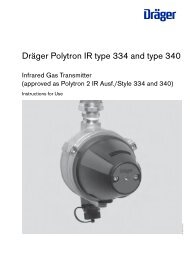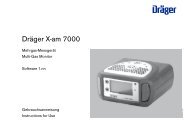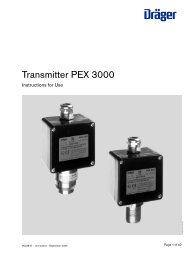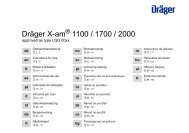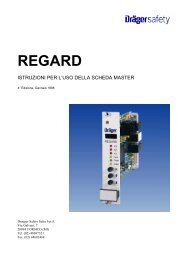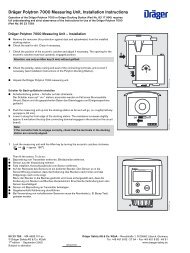Dräger Polytron 3000 - ancb.it
Dräger Polytron 3000 - ancb.it
Dräger Polytron 3000 - ancb.it
You also want an ePaper? Increase the reach of your titles
YUMPU automatically turns print PDFs into web optimized ePapers that Google loves.
Maintenance<br />
Calibrating the zero point<br />
For all sensors except oxygen sensor:<br />
The zero point can be calibrated w<strong>it</strong>hout the use of n<strong>it</strong>rogen (zero gas) when the<br />
ambient air is free from measuring gas and other interfering gases. Alternatively:<br />
<strong>Polytron</strong><br />
1 Use the calibration adapter.<br />
● Set maintenance sw<strong>it</strong>ch to maintenance pos<strong>it</strong>ion, see page 14.<br />
● Let n<strong>it</strong>rogen flow through the calibration adapter at a rate of approx. 0.5 L/min.<br />
Synthetic air may also be used, except when calibrating oxygen sensors.<br />
● Wa<strong>it</strong> for the measured value to stabilise – approx. 3 minutes. Note the information<br />
in the sensor data sheet.<br />
2 Set potentiometer for zero point so that the display shows 0 and the dig<strong>it</strong>al voltmeter<br />
0 mV ±2 mV.<br />
Oxygen sensors:<br />
The zero point cannot be calibrated for these sensors. The zero point is merely<br />
checked.<br />
1<br />
2<br />
01823758_1.eps<br />
● Sw<strong>it</strong>ch off calibration gas and remove calibration adapter.<br />
● Set maintenance sw<strong>it</strong>ch to measuring pos<strong>it</strong>ion, see page 14.<br />
Calibrating the sens<strong>it</strong>iv<strong>it</strong>y<br />
Caution:<br />
Test gas must not be inhaled. Risk to health!<br />
Care must be taken about the risks which can arise when using test gas;<br />
hazard instructions and safety advice must be observed.<br />
For details, see appropriate Safety Data Sheets.<br />
— The recommended calibration gas concentration for optimum accuracy is between<br />
40 % and 100 % of the measuring range end value.<br />
1 Use the calibration adapter.<br />
● Set maintenance sw<strong>it</strong>ch to maintenance pos<strong>it</strong>ion, see page 14.<br />
● Let calibration gas flow through the calibration adapter at a rate of approx. 0.5 L/<br />
min.<br />
— Wa<strong>it</strong> for the measured value to stabilise – approx. 3 minutes. Note the information<br />
in the sensor data sheet.<br />
<strong>Polytron</strong><br />
3 Set the potentiometer for sens<strong>it</strong>iv<strong>it</strong>y so that the display shows the concentration<br />
of the calibration gas or the dig<strong>it</strong>al voltmeter shows the calculated voltage mV.<br />
Calculation of the voltage V exp between test points TP1 and TP2:<br />
V exp = Concentration of calibration gas ÷ Measuring range x 1000 mV<br />
3<br />
Example:<br />
Concentration of calibration gas 250 ppm CO<br />
Measuring range 0 to 300 ppm CO<br />
Calculated voltage: 250 ppm<br />
V exp = x 1000 mV = 833 mV<br />
300 ppm<br />
1<br />
01923758_1.eps<br />
16



